Indonesia eCommerce Logistics Market Size
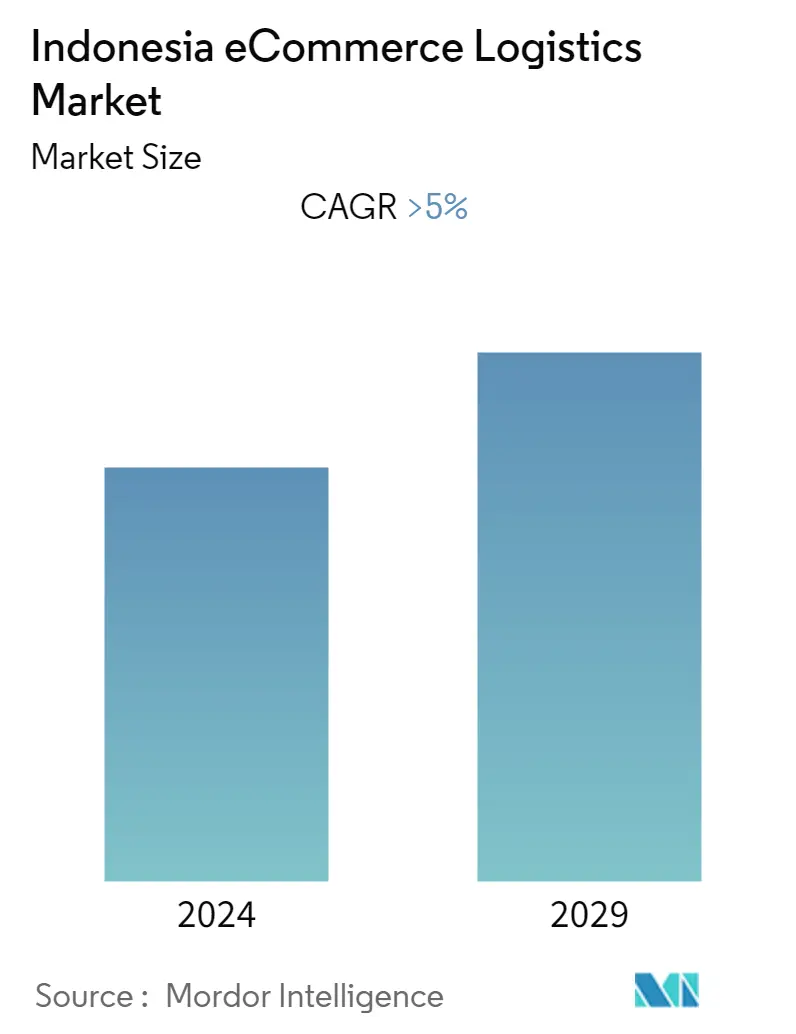
| Study Period | 2019 - 2029 |
| Base Year For Estimation | 2023 |
| Forecast Data Period | 2024 - 2029 |
| Historical Data Period | 2019 - 2022 |
| CAGR | 5.00 % |
| Market Concentration | Low |
Major Players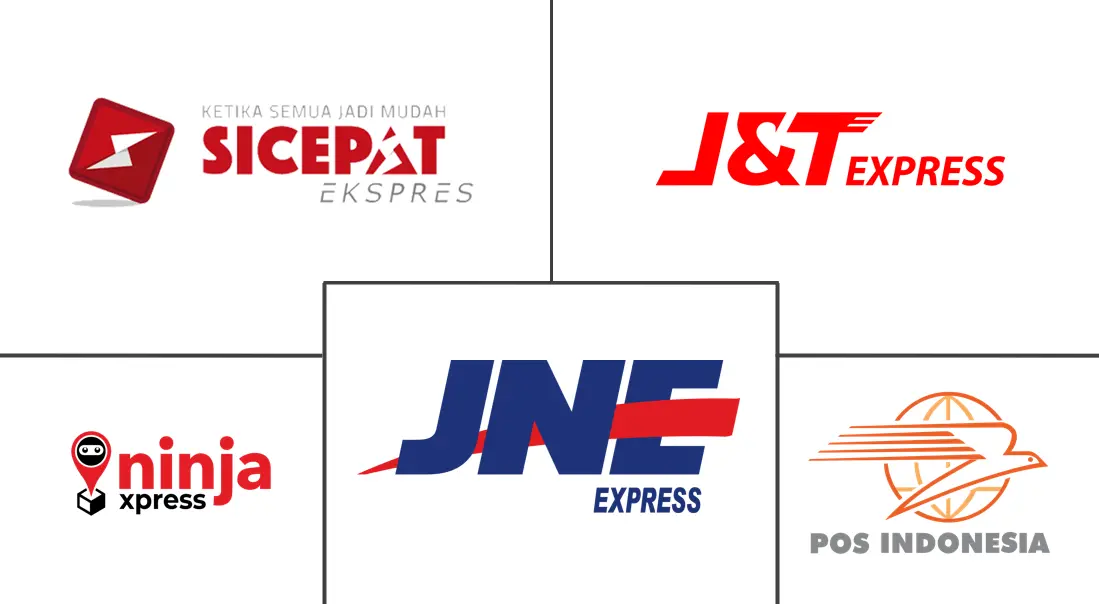
*Disclaimer: Major Players sorted in no particular order |
Indonesia eCommerce Logistics Market Analysis
During the time frame of the forecast, the Indonesia eCommerce logistics market is expected to register a CAGR of more than 5%.
- Indonesia, with its huge population, has great market potential. During the COVID-19 pandemic, e-commerce transactions increased by 23% to a projected USD 32 billion. Total online market sales in Indonesia reached USD 44 billion in 2020, with the e-commerce sector accounting for 72% of the total digital economy value. This increased the demand for eCommerce logistics services, indicating that the market performed very well during COVID-19.
- With a population of 273.5 million people, Indonesia is one of the most promising Southeast Asian e-commerce markets in the world, mainly due to the younger generation's acceptance of online shopping as a more convenient and affordable way to shop. Large and small cross-border e-commerce platforms in the country are also making people more interested in shopping online by offering cashback payments. This is making e-commerce even more popular.Indonesia has the biggest digital economy in the region, making up about 40% of the whole market.It is home to 'unicorns' such as Gojek (ride-hailing), Tokopedia (e-commerce), Bukalapak (e-commerce), and OVO (digital payment), who are resolutely spearheading the country's digitalization. They have attracted investors from all over the world, particularly large tech companies wanting to gain traction in the region. According to Indonesia's Ministry of Communication and Information Technology, about 21 million Indonesian SMBs, or 32% of the total, market their products on online marketplaces. By 2024, the government hopes to get at least 30 million SMBs online. All these factors are contributing to the growth of the market.
- However, in comparison to neighboring countries, internet penetration in Indonesia remains low. While a commercial 5G network has been launched in a few urban areas, many islands and rural areas have limited to no internet access at all. Improving logistics infrastructure continues to be a challenge in a country with approximately 17,000 islands and a vast sea area. The quality of Indonesia's workforce is fundamentally insufficient to meet the demands of its digital industry. Approximately 87% of the workforce has only completed primary and secondary school education. Compared to other Association of Southeast Asian Nations (ASEAN) countries, Indonesia's non-cash payments are still relatively underdeveloped. Another barrier to the development of e-commerce in the country is regulatory uncertainty. While the government has stated its intention to reform, changing certain inward-looking policies will be difficult. Therefore, the regulatory regime is expected to remain unpredictable. These are the challenges that Indonesia needs to overcome to see rapid market growth.
Even though more and more Indonesians are shopping online, most of the country's e-commerce customers are still in the Greater Jakarta area. It is thought that 60-70% of all online shopping in the country takes place in this area. This concentration of e-commerce in Indonesia's big cities has opened up a lot of opportunities outside Greater Jakarta. There are at least 170 million consumers in the second- and third-tier cities who have not been served optimally due to logistical barriers. In order to serve the second- and third-tier cities, several established players in the logistics industry, start-ups, and e-commerce managers are building conjoined warehouse and delivery networks.
Indonesia eCommerce Logistics Market Trends
Live Commerce Contributing in Market Expansion
Live commerce is the act of selling products online through live video while shoppers interact with the brand in real time. Live commerce has transformed into a lucrative industry in the Indonesian and overall Southeast Asian digital ecosystems, especially after seeing how China managed to scale up the system into one of its strongest sales campaigns. Several industries have adopted live shopping to market their products. According to a survey on live shopping in Indonesia conducted in October 2022, 69% of the respondents in Indonesia have purchased products using Livestream commerce. 57% of Indonesian respondents used an e-commerce platform to watch live shopping. E-commerce platforms in Indonesia adopt live shopping to improve customer engagement and push sales. Shopee was the leading e-commerce platform for live shopping. 69% of Indonesian respondents used TikTok to watch live shopping. The attractive discount was the main reason why Indonesians shopped from live shopping promotions, as stated by 66% of respondents. Fashion products were the most popular products Indonesians bought from live shopping promotions. 50% of Indonesian respondents stated that they were interested in buying items from a live shopping promotion.
While bigger brands tend to use live shopping to push new products or sales, the benefits of the approach manifest differently for small-scale sellers. For these merchants, videos are a front-end funnel to entice new potential buyers and serve as an invitation for customers to get to know their brands and products more. For new merchants, the average Livestream can increase product viewership and shop visits by 40% and 20%, respectively, while driving 29% of their orders for the day. Overall, live streaming can also lead to an increase of up to 625x more product detail page views, a 262x increase in shop visits, and up to 100% of the shop's daily orders. In some cases, small brands have been able to attract more than 80,000 viewers from a piece of content generated as part of their live shopping efforts. For Indonesia's nearly 65 million small and medium-sized businesses (SMBs)-nearly 98% of which are micro-enterprises with less than IDR 300 million (USD 19,500) in annual sales-the trend could open doors to new customers amid a government push towards digitalization. Considering this, live commerce will see tremendous growth in Indonesia in the coming years. With this growth of live commerce, the Indonesian eCommerce logistics market will see continued expansion.
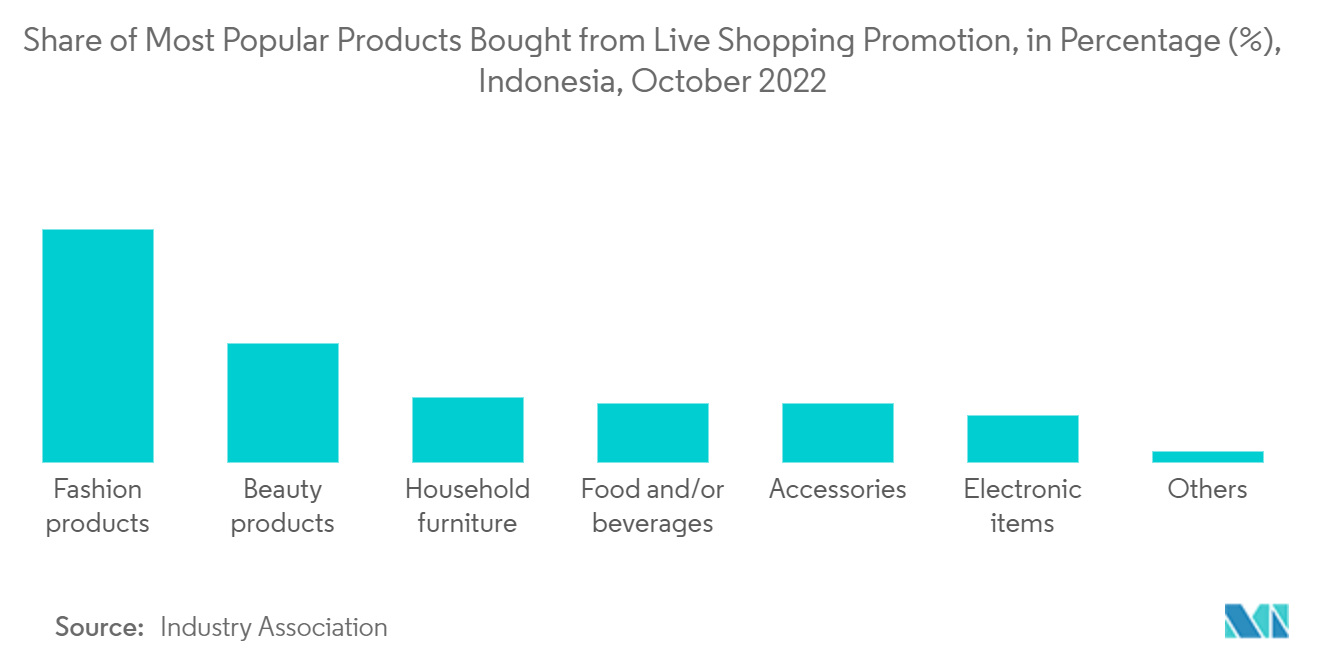
Government Regulations can Negatively Impact the Market
The growth of e-commerce in Indonesia has made a big difference in the economy of the whole country.However, data also shows that foreign products dominate the e-commerce market in Indonesia, which is dangerous for the domestic economy. The Indonesian Institute of Sciences (LIPI) conducted a survey related to online commerce (e-commerce) in Indonesia, which is flooded by 90% of foreign products. This has an impact; imports of goods through e-commerce have increased sharply. The implication is that the competitiveness of domestic products is weakening. The trend of importing goods through e-commerce needs special attention from the government. Data from Customs said that throughout 2018, the average amount of goods imported through e-commerce increased by 10.5% per month, while in terms of transaction value, it jumped 22% from the previous year. There are several reasons why imported goods sell well in the Indonesian e-commerce market. First, consumers shop for goods from abroad because the product is rare in the market. Secondly, the price of goods is rated relatively low by buyers. In fact, some e-commerce platforms in Indonesia provide facilities for foreign sellers to open online stores in the country. According to some industry experts, if this is not followed up immediately, it will further threaten the business continuity of online producers and sellers in Indonesia.
The Indonesian government is taking steps in this direction. Indonesia plans to restrict online retailers, especially e-commerce, from entering the country, according to Indonesia's Minister of Cooperatives and SMEs. The ministry has suggested changes to Trade Minister Regulation No. 50/2020 on business permits, marketing, and overseeing trade across electronic systems, or PMSE. The minister underlined that this plan is needed to better maintain the products that are marketed domestically. There are currently many foreign e-commerce players that can directly conduct sales in the Southeast Asian nation, but the products fail to meet the Indonesian National Standard (SNI) or marketing authorization from the Food and Drug Monitoring Agency (BPOM). According to the minister, any international eCommerce should basically be allowed to enter the Indonesian market but must be required to establish a company in Indonesia. The ministry hopes that as the restriction policy is implemented in the future, micro, small, and medium-sized enterprises will not be left out or unable to compete with imported products sold on foreign e-commerce platforms, which are mostly cheaper compared to domestic goods. The government hopes that as the restriction policy is implemented in the future, micro, small, and medium-sized enterprises will not be left out or unable to compete with imported products sold on foreign e-commerce platforms. However, this could lead to reduced eCommerce demand and negatively impact the market.
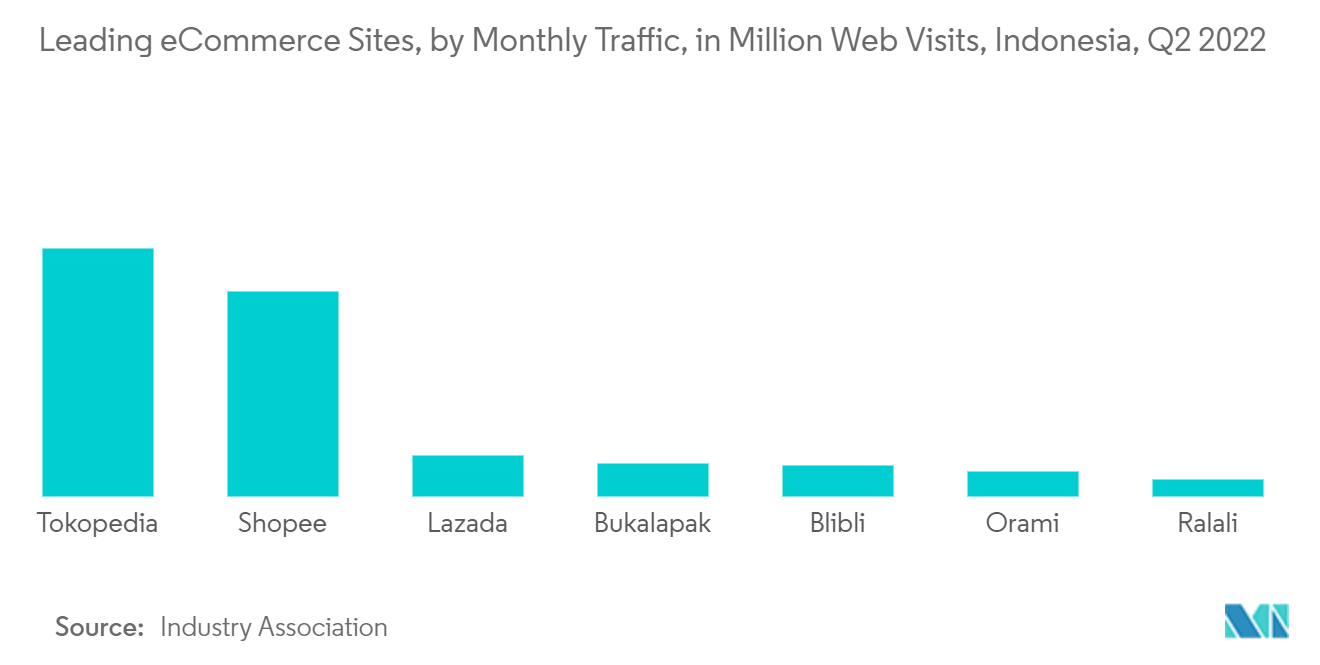
Indonesia eCommerce Logistics Industry Overview
The Indonesian e-commerce logistics market is fragmented by nature. The demand for eCommerce logistics services is growing rapidly across the country, and companies are becoming more competitive to capture this opportunity. Major international players are making strategic investments to establish a regional logistics network, such as opening new distribution centers and smart warehouses. JNE Express, SiCepat Ekspres Indonesia, Ninja Xpress, J&T Express, and POS Indonesia are some of the major players in the market. To maintain cost competitiveness, companies that operate online prefer to work with third-party courier providers instead of hiring in-house delivery staff. Global companies are actively investing in the region to benefit from the growth opportunities. DHL and UPS are the two major global players active in the market.
Indonesia eCommerce Logistics Market Leaders
-
JNE Express
-
SiCepat Ekspres Indonesia
-
Ninja Xpress
-
J&T Express
-
POS Indonesia
*Disclaimer: Major Players sorted in no particular order
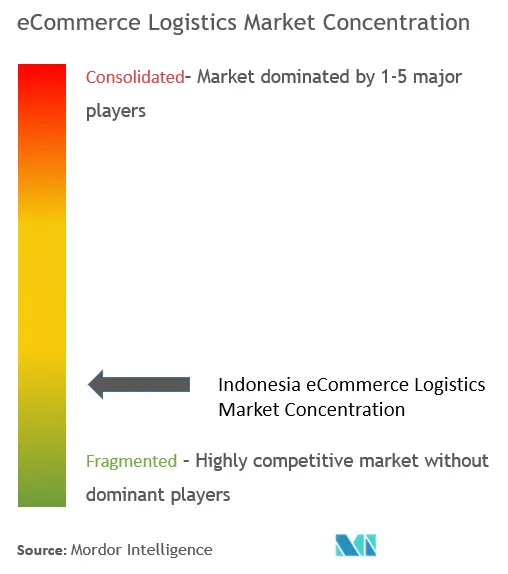
Indonesia eCommerce Logistics Market News
- August 2022: Global logistics service provider J&T Express announced the expansion of two sorting centers in Indonesia to meet growing local business demand and upgrade the work environment for employees, along with a free shipping campaign for customers, in celebration of the company's seventh anniversary in the country. To meet the rising demand for delivery services, the two upgraded sorting warehouses in the cities of Madiun and Banjarmasin each cover an area of about 20,000 square meters, with a building area of more than 12,000 square meters.
- December 2022: Singapore-based Ninja Van is bolstering its package delivery capabilities in Indonesia by teaming up with local carrier Trigana Air. Under the partnership, a Boeing 737-300 plane with a capacity of up to 15.5 tons will deliver packages from Jakarta, the Indonesian capital located on Java island, to Sulawesi, Kalimantan, and Sumatra. It has been operating daily since December 11. The company also offers Logistics+, a supply chain management solution aimed at SMEs that includes procurement, payment, financing, fulfillment, and distribution services.
Indonesia eCommerce Logistics Market Report - Table of Contents
1. INTRODUCTION
- 1.1 Study Assumptions and Market Definition
- 1.2 Scope of the Study
2. RESEARCH METHODOLOGY
3. EXECUTIVE SUMMARY
4. MARKET INSIGHTS AND DYNAMICS
- 4.1 Current Market Scenario
- 4.2 Market Drivers
- 4.3 Market Restraints
- 4.4 Market Opportunities
- 4.5 Value Chain / Supply Chain Analysis
-
4.6 Industry Attractiveness - Porter's Five Forces Analysis
- 4.6.1 Threat of New Entrants
- 4.6.2 Bargaining Power of Buyers/Consumers
- 4.6.3 Bargaining Power of Suppliers
- 4.6.4 Threat of Substitute Products
- 4.6.5 Intensity of Competitive Rivalry
- 4.7 Government Initiatives and Regulations
- 4.8 Technological Trends in the Market
- 4.9 Insights on the E-commerce Market
- 4.10 Insights into Reverse/Return Logistics
- 4.11 Impact of COVID-19 on the Market
5. MARKET SEGMENTATION
-
5.1 By Service
- 5.1.1 Transportation
- 5.1.2 Warehousing and Inventory Management
- 5.1.3 Value added services (Labeling, Packaging)
-
5.2 By Business
- 5.2.1 B2B
- 5.2.2 B2C
-
5.3 By Destination
- 5.3.1 Domestic
- 5.3.2 International/Cross-border
-
5.4 By Product
- 5.4.1 Fashion and Apparel
- 5.4.2 Consumer Electronics
- 5.4.3 Home Appliances
- 5.4.4 Furniture
- 5.4.5 Beauty and Personal care products
- 5.4.6 Other products (Toys, Food Products, etc.)
6. COMPETITIVE LANDSCAPE
- 6.1 Market Concentration Overview
-
6.2 Company Profiles
- 6.2.1 JNE Express
- 6.2.2 SiCepat Ekspres Indonesia
- 6.2.3 Ninja Xpress
- 6.2.4 Lion Parcel
- 6.2.5 Wahana Express
- 6.2.6 Paxel
- 6.2.7 J&T Express
- 6.2.8 DHL Express
- 6.2.9 UPS
- 6.2.10 POS Indonesia*
- *List Not Exhaustive
7. FUTURE OF THE MARKET
** Subject To AvailablityIndonesia eCommerce Logistics Industry Segmentation
The term "e-commerce logistics" refers to the transportation, warehousing, and distribution services provided to an online retailer by the logistics company. The Indonesia eCommerce Logistics Market is segmented by service (transportation, warehousing and inventory management, and value-added services), by business (B2B and B2C), by destination (domestic and international/cross-border), and by product (fashion and apparel, consumer electronics, home appliances, furniture, beauty and personal care products, and other products). The report offers market sizes and forecasts in value (USD billion) for all the above segments.
| By Service | Transportation |
| Warehousing and Inventory Management | |
| Value added services (Labeling, Packaging) | |
| By Business | B2B |
| B2C | |
| By Destination | Domestic |
| International/Cross-border | |
| By Product | Fashion and Apparel |
| Consumer Electronics | |
| Home Appliances | |
| Furniture | |
| Beauty and Personal care products | |
| Other products (Toys, Food Products, etc.) |
Indonesia eCommerce Logistics Market Research FAQs
What is the current Indonesia eCommerce Logistics Market size?
The Indonesia eCommerce Logistics Market is projected to register a CAGR of greater than 5% during the forecast period (2024-2029)
Who are the key players in Indonesia eCommerce Logistics Market?
JNE Express, SiCepat Ekspres Indonesia, Ninja Xpress, J&T Express and POS Indonesia are the major companies operating in the Indonesia eCommerce Logistics Market.
What years does this Indonesia eCommerce Logistics Market cover?
The report covers the Indonesia eCommerce Logistics Market historical market size for years: 2019, 2020, 2021, 2022 and 2023. The report also forecasts the Indonesia eCommerce Logistics Market size for years: 2024, 2025, 2026, 2027, 2028 and 2029.
Indonesia eCommerce Logistics Industry Report
Statistics for the 2024 Indonesia eCommerce Logistics market share, size and revenue growth rate, created by Mordor Intelligence™ Industry Reports. Indonesia eCommerce Logistics analysis includes a market forecast outlook to 2029 and historical overview. Get a sample of this industry analysis as a free report PDF download.



